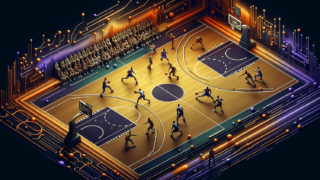
Do you know that feeling of exhilaration when you uncover a new tactic that can leave even the toughest opponents confused? In the world of basketball, a variety of strategies can achieve just that, and among the many effective defensive schemes lies the 2-1-2 Zone Defense. So, hold on tight, as we delve into the ins and outs of this fascinating formation. If you’re looking to sharpen your basketball knowledge and potentially step up your gameplay, you’ve come to the right place. Join us as we embark on this enlightening journey towards understanding the 2-1-2 Zone Defense in basketball and all its intriguing nuances.
What’s a 2-1-2 Zone Defense in Basketball?
A 2-1-2 Zone Defense is a strategic basketball formation in which defenders are arranged into two frontcourt players, one at the top, and two backcourt players, creating a distinct 2-1-2 pattern on the court. This defensive approach focuses on covering specific areas or zones rather than matching up with individual offensive players. The primary goal is to obstruct passing lanes, stifle shots from the key, and contain dribble penetration, making it a versatile and effective strategy for both disrupting offenses and protecting the rim.
Understanding the Fundamentals of 2-1-2 Zone Defense
Before we jump into the intricacies, let’s begin with the basics to ensure that everyone is on the same page. Zone defenses, including the tactical 2-1-2 formation, are quite prevalent in basketball. By asking players to protect specific areas of the court rather than guard specific opponents, these formations dissolve some of basketball’s man-to-man strategy. The 2-1-2 Zone Defense is organized into three layers: two frontcourt players standing near the wing areas, one player placed near the free-throw line, and the remaining two backcourt players defending near the corners of the key.
Key Responsibilities of Each Player
To unlock the full potential of the 2-1-2 Zone Defense, every player must understand their role and positioning within the strategy. Let’s take a closer look at each player’s responsibilities in this formation.
Frontcourt Players (2)
The two frontcourt players, typically small forwards or shooting guards, are responsible for guarding the wings and the post areas of the court. Their main duties include:
- Putting pressure on wing players and preventing quick ball reversals.
- Contesting shots from the wing and the elbow without getting beaten off the dribble.
- Reading the offensive posts and moving accordingly to disrupt their actions.
Midcourt Player (1)
The midcourt player (often a point guard), known as the “rover” in this defense, is stationed near the free-throw line—making this position critical in the 2-1-2 formation. Key responsibilities include:
- Guarding the high post, ensuring the offensive player cannot find space for a quick shot.
- Defending the middle against the fast break and ensuring a balanced court coverage.
- Helping teammates block passing lanes and recover to their original positions after rotations.
Backcourt Players (2)
In the 2-1-2 formation, these two players, usually power forwards or centers, cover the low post area and the baseline corners. Their primary responsibilities involve:
- Preventing easy passes into the low post, which often lead to high percentage shots.
- Rebounding offensive and defensive boards—this position usually calls for strong rebounders.
- Providing weak side help when the ball is on the opposite wing and recovering quickly to the corner shooters.
Breaking Down the Benefits of the 2-1-2 Zone Defense
As with any strategic move, the 2-1-2 Zone Defense brings unique advantages to the table. Let’s explore the benefits of employing this formation and how it can give your team a defensive edge in the world of basketball.
Disrupting Offensive Rhythm
By clogging the middle and blocking passing lanes, the 2-1-2 Zone Defense can make it difficult for opponents to execute their plays. Offenses that have difficulty playing against zone defenses will likely struggle to establish a comfortable rhythm, ultimately leaving them frustrated and disorganized.
Forcing Low Percentage Shots
The 2-1-2 Zone Defense compels teams to take more outside shots, which are generally less accurate than inside attempts. By positioning around the key and closing out aggressively, teams can challenge these perimeter shots, decreasing the opponents’ shooting percentage.
Neutralizing Dominant Post Players
For teams facing dominant big men or physically superior opponents, the 2-1-2 Zone Defense offers the means to stay competitive. By defending the high and low post, teams can make it challenging for these players to score in the paint or even receive the basketball in their preferred positions.
Control the Tempo
One of the most significant benefits of the 2-1-2 Zone Defense is its ability to dictate a slower pace during games. By limiting fast breaks and encouraging offenses to work patiently around the zone, defenses can control the tempo, which is particularly valuable when playing against fast, athletic teams.
Countering Common Challenges in the 2-1-2 Zone Defense
Although the 2-1-2 Zone Defense is a versatile and effective strategy, it isn’t without its challenges. Let’s dive into some common problems faced by teams employing this formation and discuss solutions to mitigate these vulnerabilities.
Stretching the Zone with Outside Shooters
Skilled outside shooters may pose a threat to the 2-1-2 defense by stretching the zone, which in turn creates gaps in the coverage. When faced with a team of exceptional shooters, teams can adjust by extending the defensive pressure on the perimeter—an alteration commonly known as an extended 2-1-2 zone.
Exploiting Open Areas with Quick Ball Movement
A quick-passing team can cause issues by finding open spaces in the 2-1-2 Zone Defense. To combat this, defenders must improve their communication and rotation skills. Anticipating offensive movement and reacting quickly will help minimize vulnerability and deter opponents from exploiting gaps.
Defensive Rebounding and Challenging Second Chance Shots
Zone defenses can leave teams susceptible to second-chance opportunities due to a lack of box out assignments. In the 2-1-2 formation, sending the two backcourt players to crash the boards can help boost defensive rebounding. Practicing box out techniques as a team will also help secure rebounds and disrupt offensive rebounds for opposing teams.
Adapting the 2-1-2 Zone Defense for Different Levels of Competition
While versatile by nature, the 2-1-2 Zone Defense can be adapted to suit specific levels of competition—offering unique advantages depending on the opponents’ strengths, weaknesses, and style of play. Below, we’ll explore how to adjust the defensive approach at different levels of play.
Youth Basketball
In youth basketball, teams can simplify the 2-1-2 Zone Defense by focusing on fundamentals and positioning. The emphasis should be on stopping dribble penetration, contesting shots, and securing rebounds to instill strong defensive habits within the players.
High School Basketball
At the high school level, coaches can incorporate more sophisticated concepts, such as rotations and close-outs. Additional adjustments, like the extended 2-1-2 defense, can also be introduced to improve players’ understanding of how their role in the defense can change based on the opponent’s actions.
College and Professional Basketball
As players advance to college and professional levels, the 2-1-2 Zone Defense can be refined even further to accommodate the nuances of the game. Strategizing around the strengths and weaknesses of specific opponents by employing half-court traps and aggressive close-outs will serve as powerful tools for teams seeking to disrupt high-level offenses.
Wrap Up: The 2-1-2 Zone Defense Effectiveness in Basketball
Ultimately, the 2-1-2 Zone Defense presents an effective and versatile defensive option that can benefit teams at all levels of competition. By focusing on teamwork, communication, and strong fundamentals, your entire squad can stand united, ready to disrupt any opposing basketball offense. With continuous improvement and proper coaching, this strategic formation will undoubtedly become a powerful weapon in your team’s defensive arsenal.
Mastering the 2-1-2 Zone Defense: Tips and Techniques
Now that we’ve covered the essentials of the 2-1-2 Zone Defense, let’s dive into tips and techniques to help your team reach peak performance using this formation. Enhancing your strategic knowledge will enable your team to tackle matchups more effectively, making opponents work hard to find scoring opportunities.
Effective Communication Is Key
As the cornerstone of any zone defense, communication between players is crucial for success. Teammates need to be vocal about opponent movement, screens, rotations, and potential threats. By continuously updating each other about what’s happening on the court, players can adapt and respond more quickly—ensuring that defensive coverage is always strong.
Positioning and Court Awareness
Knowing where you need to be on the court is only half the battle. Players should strive to establish a high level of court awareness while maintaining proper spacing within the 2-1-2 formation. Anticipating opponent movement and adjusting positions accordingly will keep your zone defense strong and efficient.
Maintaining High Defensive Energy
A crucial element of the 2-1-2 Zone Defense is the consistent application of pressure on opponents. Players need to actively contest passes, block shots, and disrupt passing lanes. High defensive energy throughout the team can lead to turnovers, deflections, and steals, providing scoring opportunities on the other end.
Stressing on Defensive Rebounds
A weakness of most zone defenses is securing defensive rebounds. All players need to understand the importance of boxing out and pursuing successful rebounds during the game. By controlling the defensive glass, your team will limit second-chance points for the opposition and create more opportunities to initiate your own offensive game plan.
Evolution of the 2-1-2 Zone Defense
Over the years, coaches have developed various adaptations to the traditional 2-1-2 Zone Defense, creating hybrid schemes to cater to specific needs. Let’s explore some of these innovative strategies and how they can change a team’s defensive outlook.
Match-up Zone Defense
The match-up zone defense combines elements of man-to-man and zone principles to provide greater adaptability in defending the court. With this strategy, players in the 2-1-2 formation pick up specific offensive players based on where they are on the court, allowing for more aggressive defense while maintaining the benefits of a zone coverage.
1-2-2 Zone Defense
In this variation of the 2-1-2 Zone, one top player (usually the point guard) pressures the ball, while the two frontcourt players play closer to the middle of the court. This adjustment places one extra defender at the top, providing strong defense on the perimeter and forcing offenses into taking low percentage shots.
Amoeba Defense
Developed by legendary UNLV coach Jerry Tarkanian, the Amoeba Defense is an adaptation of the 2-1-2 Zone Defense that emphasizes trapping and employing aggressive pressure on the ball handler. The flexible nature of this defense hinges on closing out aggressively and constantly switching defensive responsibilities to confuse and disrupt the opponent’s offense.
With these techniques and evolutions of the traditional 2-1-2 Zone Defense in mind, your team can adapt to a variety of challenging situations on the basketball court. The implementation of these strategic tools will elevate your team’s overall defensive game while posing a formidable challenge to opponents, regardless of their offensive prowess.
Frequently Asked Questions (FAQ) on the 2-1-2 Zone Defense in Basketball
To help you better understand the intricacies and nuances of the 2-1-2 Zone Defense, we’ve compiled a list of frequently asked questions and NLP-style answers. With this added knowledge, you’ll be well-equipped to analyze and implement this defensive strategy in your basketball games effectively.
1. When should a team use the 2-1-2 Zone Defense?
A team can use the 2-1-2 Zone Defense when they want to control the game’s tempo, force opponents to take low percentage shots, or neutralize dominant post players. It can also be employed to counter opponents who struggle against zone defenses or if a team wants to minimize the individual matchups of quicker or more athletic opponents.
2. How do you beat a 2-1-2 Zone Defense?
Teams can beat the 2-1-2 Zone Defense by employing quick ball movement, using effective outside shooting, and exploiting gaps in the zone through sharp cuts and inside passes. Additionally, offensive rebounding can pose problems for teams playing in a zone, so focusing on second-chance points may increase the chances of success.
3. Are there any weaknesses to the 2-1-2 Zone Defense?
Weaknesses of the 2-1-2 Zone Defense include difficulty in securing defensive rebounds, vulnerability to teams with strong outside shooting, and susceptibility to quick-passing teams that can find open spaces in the zone. To counter these weaknesses, teams should focus on effective communication, continuous rotation, boxing out, and adapting the formation based on specific opponents or game situations.
4. How should a team practice the 2-1-2 Zone Defense?
When practicing the 2-1-2 Zone Defense, teams should focus on fundamentals such as proper positioning, communication, court awareness, and rotations. Performing drills that emphasize these skills will help enhance the overall understanding and execution of this defensive strategy.
5. What is the difference between a match-up zone and a traditional 2-1-2 Zone Defense?
A match-up zone defense combines elements of man-to-man and zone principles, making it more adaptive in defending the court. Players in the 2-1-2 formation pick up specific offensive players based on their locations on the court, allowing for more aggressive defense while maintaining the benefits of zone coverage.
6. Can a team use the 2-1-2 Zone Defense as their primary defensive strategy?
Yes, a team can use the 2-1-2 Zone Defense as their primary defensive strategy if it suits their personnel and style of play. However, it’s essential to be prepared to adjust and adapt based on opponents’ abilities, strengths, and weaknesses. A team should have various defensive strategies in their arsenal to be more versatile during games.
7. How does the 2-1-2 Zone Defense differ from a 2-3 Zone Defense?
In the 2-1-2 Zone Defense, there’s one player near the free-throw line, while the remaining players form a 2-2 pattern. In contrast, the 2-3 Zone Defense has the defenders in a 2-3 pattern with two players at the top and three along the baseline. The key difference lies in the responsibilities and coverage area of the middle defender in each formation.
8. What is the 1-2-2 Zone Defense?
The 1-2-2 Zone Defense is a variation of the 2-1-2 Zone Defense, with the top player pressuring the ball and the other two frontcourt players playing closer to the middle of the court. This defensive strategy places an extra defender at the top, providing a stronger perimeter defense and forcing the offense into taking low percentage shots.
9. How can a team improve their defensive rebounding in a 2-1-2 Zone Defense?
Teams can improve their defensive rebounding in a 2-1-2 Zone Defense by emphasizing boxing out, having backcourt players crash the boards, and maintaining strong communication amongst all players. Practicing these techniques will help maximize the effectiveness of the zone and reduce the number of second-chance points for opponents.
10. Who developed the Amoeba Defense, and how is it related to the 2-1-2 Zone Defense?
Legendary UNLV coach Jerry Tarkanian developed the Amoeba Defense. It is an
Featured Posts
- No pillar pages found.





